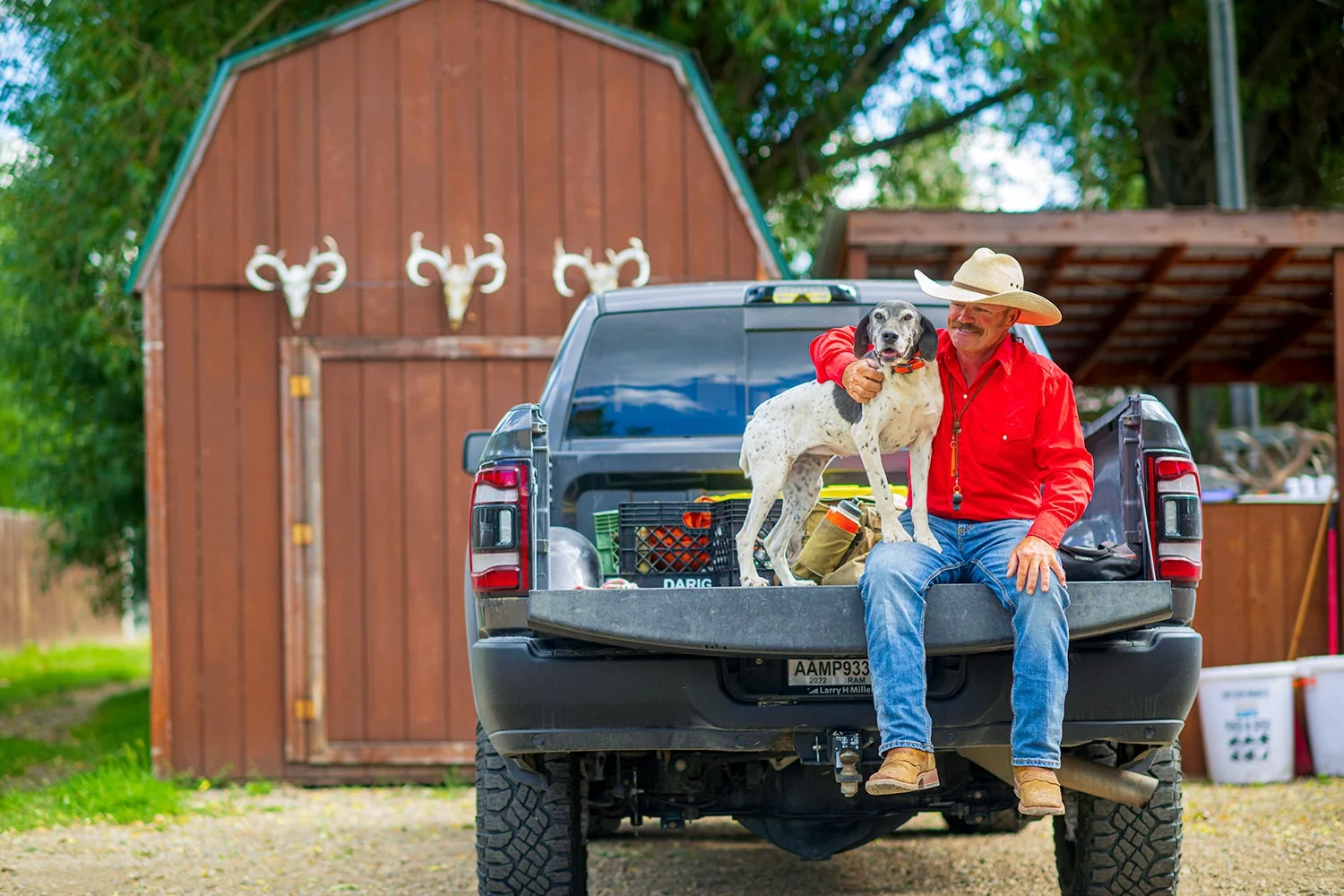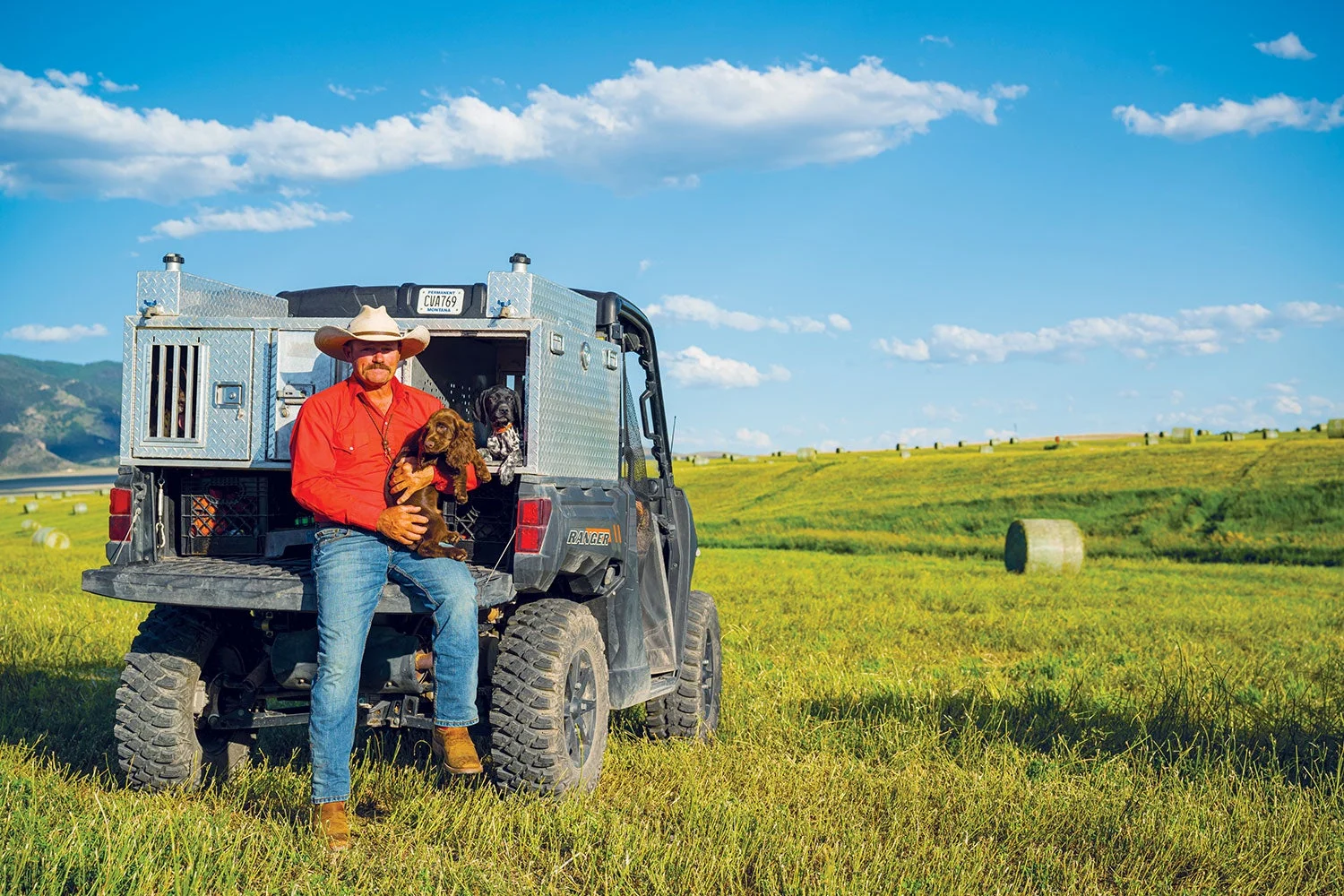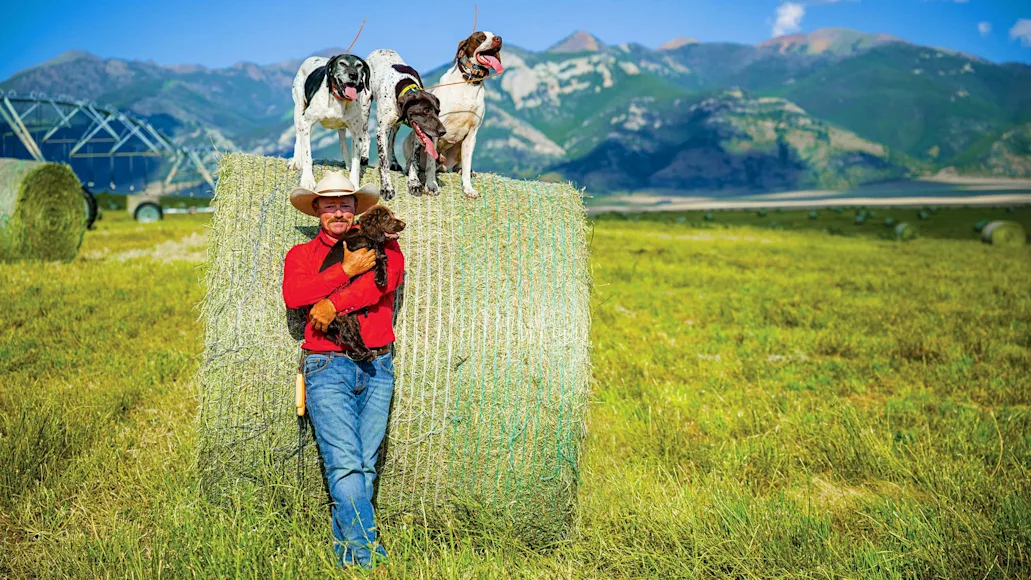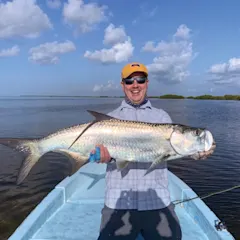I GOT MY NICKNAME from an old hillbilly from Arkansas whose boat I captained up in southeast Alaska for about 10 years. He said working with me was like working with a barnyard rooster.
I was born on a dairy farm in western Massachusetts. We were the last farm to deliver milk door to door, and back in the late ’70s, and throughout the ’80s, I helped my grandfather run his trapline. The line was close to 200 miles long, and we’d drive it every day in November. The fur trade back then was pretty good money, especially for us dairy farmers. I learned a lifetime of lessons from my grandfather—not only about trapping, but also fishing, bird hunting, putting meat in the freezer, and the knowledge that conservation, as a tool, starts with sportsmen.
My youngest daughter, Cady, is 12 and just loves to walk with the bird dogs. My oldest daughter, McCall, is 17 and definitely has some of my DNA. She puts a big bull elk on the ground every year and a nice whitetail and usually a big mule deer. I don’t think I realized exactly how much I would love spending time outside with my daughters. It’s at the point now where I almost don’t want to do anything if I can’t take them with me.

Scout, a 12-year-old GSP, is the oldest gun dog in Leavens’ kennel. Brian Grossenbacher
To live in Montana year-round, you’ve got to be a hardy soul. To live here, you have to earn it. But the 30-degrees-below-zero days in February, they just make that perfect October morning smell that much nicer, the sun that much clearer.
November 12, 2020: I woke up not feeling well at all. I had recently recovered from COVID, so I called my ex-wife, who’s a doctor, and told her how I was feeling. She said, “You probably have pneumonia and COVID is coming back. You should get some rest.” Naturally, I disregarded her advice and went deer hunting. Then the next morning, I woke up and had a feeling that I’d not ever felt before. Clearly something was wrong. I went into my ex-wife’s clinic. She took one look at me and said, “Let me listen to your lungs.” She said my lungs weren’t the problem. “You better get to the emergency room.” So I went in. Turns out, I’d had a heart attack—and was about to have another one. They loaded me up in the meat wagon and got me the hell out of there to the hospital in Bozeman. I made the ambulance driver stop as he went past my house and had him run in and get my daughter McCall. I wanted to say goodbye. From the back of the ambulance, I told her that I was in good hands, but that I didn’t know what was going to happen. I woke up from surgery at 4 a.m. the next day and called McCall. I don’t think the phone completed its first ring before she picked up. She’d stayed up all night waiting for that call.
I’m a big fan of walking. I’ll walk near a thousand miles between September and February, during bird season. My doctor said that’s why I lived through my heart attack.
I’ve got everything from 6 months old to 12 years old in my kennel right now. There’s the old dog, Scout. She’s a German shorthaired pointer. The next one down the line is Pedro. He’s an English pointer that came out of south Texas. After Pedro is Chili Pepper. She’s another German shorthaired pointer from Minnesota. After Chili Pepper is Amos Moses, named after a man of the cloth. He’s another German shorthaired pointer. I’ve got a little English setter named Texas. Guess where she came from? And then I’ve got a new little English cocker. His name is Wacho, which translates into Little Rascal in Spanish.
A good dog name has got to have some sort of story behind it. I’ll never have a dog that’s got a boring name.
Every time you put a dog on the ground, drop a couple shells in your gun, and snap it closed. You never know what you’re going to find in the next few hours.

“What do I look for in a pup?” Leavens says. “Honestly, when you have two daughters like I do, you look for the one your girls like.” Brian Grossenbacher
You and your dog—an animal that you’ve trained from a pup to whatever age dog you’re running with—are trying to outsmart a wild animal that doesn’t always sit tight and let you shoot at it. Wild birds look for every reason in the world to get out of there. When your dog goes on point, there are all of these different factors you need to consider. Do the birds want to hold? And if they do hold, can I even hit them? How’s my footing? Am I wearing too many clothes to mount my gun properly? Did I swing through the bird? Did I wait and shoot the second bird, or did I dump both barrels on the first bird that got up? Did I shoot clean? What did I see? So, when your dog goes on point, you have to be Right. There. You can’t be thinking about anything else that might be eating at you that day: Your old lady’s mad at you or your kids are getting bad grades or whatever it is that has you feeling off. You can’t be thinking about any of that once your dog goes on point. That’s why I love bird hunting.
With training dogs, it’s all about establishing a working relationship with them and establishing trust. If you’re scatterbrained and you’re texting or taking a phone call, guess what? That’s exactly when your dog will get in some sort of trouble. And, really, our number-one job is to just keep those rascals alive. It doesn’t take much for things to go south when you’re working dogs like that.
Part of owning dogs is losing them. I’ve got a rack of all their collars in my gear room.
This year, I lost a really good German shorthaired named Sancho. His name meant the The Other Guy in Latin slang—the kind of guy who goes out the back window when you get home. Anyway, Sancho was a hell of a dog and he died at about 6 years old. Way too young. I was packing his body up a chukar ridge—about 3,000 feet up—when one of the other dogs with me went on point. A covey of chukars flushed. I didn’t shoot, of course. I buried Sancho there, under a pile of lava rocks where the covey flushed. I wrote a note on an old box of shotgun shells that said something to the effect of, Here lies Sancho. If you’re running low on shells, grab a couple. A month or so later, I took one of my best buddies up there. He really liked Sancho. We put a couple dogs out and started walking and I said, “He’s buried on that highest point up there.” When we got up there, that same covey of chukars was sitting on his grave.
Most of the good things in life aren’t easy to talk about.

For Leavens, bird season starts near the Canadian border in September and lasts until he and his dogs have hunted their way south, all the way to the Mexican border, in February. Brian Grossenbacher
A customer of mine once said to me: “Everybody wants adventure, until the adventure starts.” I suppose that’s about as close to a motto as I’ll ever have.
I only want to hunt and fish with people who are honest and trustworthy.
I love the Big Hole River because it’s as wild as it was centuries ago. And it takes a certain amount of appreciation to understand what you’re being given the opportunity to do when you fish it. You feel like you’re kind of becoming one with the river and understanding the nuances of water flows and river temperatures and where the fish live and what they’re feeding on. And the very next day, it changes because the water’s dropped two or three inches. The Big Hole keeps you on your toes, which I like. I don’t enjoy monotony.
I love to talk, God knows that, but there’s a time to focus—and it’s when the trout are up and the bugs are out. Let’s pay attention to what we’re doing here. I’ll row as hard as guys want to fish. If they’re pausing on their back cast well and hitting the spots and tending their line and they’re focused—if they’re present—then I’ll be present to the nth degree.

Leavens appeared on the June 2014 cover of F&S, in a photograph by Brian Grossenbacher. Field & Stream
I’m looking right now at the cover of Field & Stream that I was on. [Editor’s note: Leavens appeared fly fishing on the June 2014 cover.] I’ve got it in a frame above my desk. I don’t know if you’d call it a coming-of-age moment or what, but here’s the magazine that I read religiously as a child—and there I am on the cover. Pretty neat.
Patience, patience, patience. The best advice I can give you—whether it’s for fly fishing, dog training, or bird hunting—can be summed up in that one word. Nothing happens overnight. Everything requires patience, and with patience you’ll see rewards.
November 12, 2021: I shot a clean limit of chukars—eight chukars in western Idaho over my two favorite dogs—on the one-year anniversary of my heart attack. That was a pretty big deal to me. I’d never shot a limit of chukars. Anymore, we’re happy to get a chukar or two on a hunt. To get eight—that’s a lot. There were birds everywhere that day, talking and chattering and running up and down the ridges. At one point, a herd of elk took off underneath me. I was exactly where I needed to be.
I haven’t said no to much of anything since my heart attack. I’m not going to look back and say, “God, I wish I’d have done that,” or, “I wish I would’ve taken the girls to do that.” I’m just not going to do that. There’s going to be a long list of places I’ve been before I check out.
If I can come close to being remembered the way my grandfather is remembered—as an upstanding citizen in the outdoor world, as a leader—then I’ll have done all right.
I very rarely hunt alone.
Misery can be a flat tire in the middle of nowhere. Misery can be a person who has very unrealistic expectations of the fishery and of myself as a guide. Misery comes in a lot of different forms.
My favorite place to hunt? God, wherever the dog’s on point.
Happiness, for me, typically comes at the end of the day, when I’m putting gear away or kenneling healthy dogs. The work’s done for the day, and I feel like I’ve accomplished something. Beyond that, I like ending a day with a rib eye on charcoal, bourbon on ice, and a phone call to my girls.
_Read more F&S+
stories._






